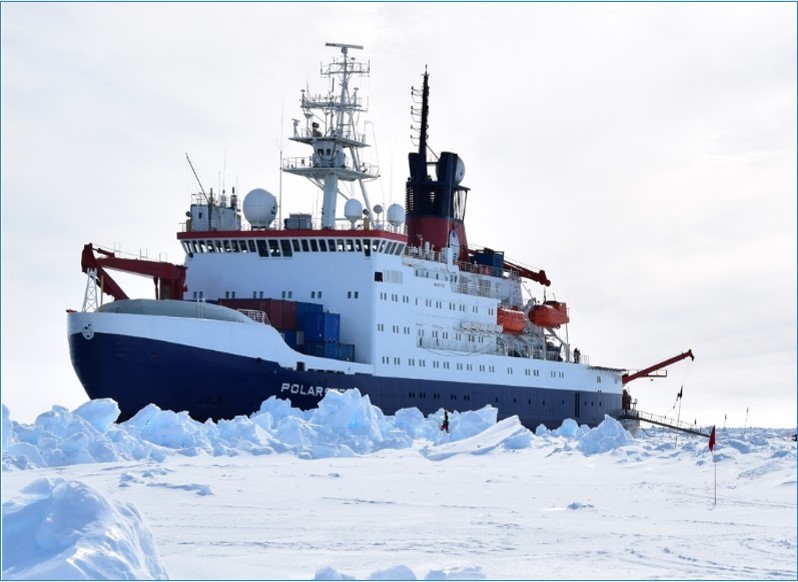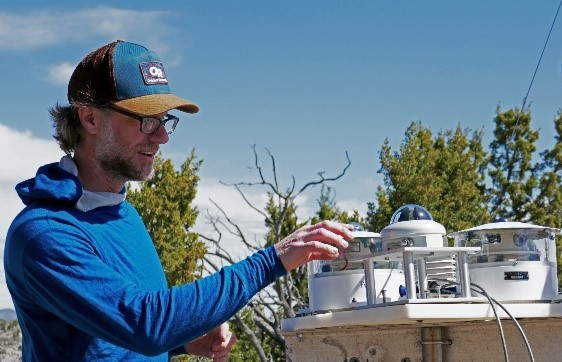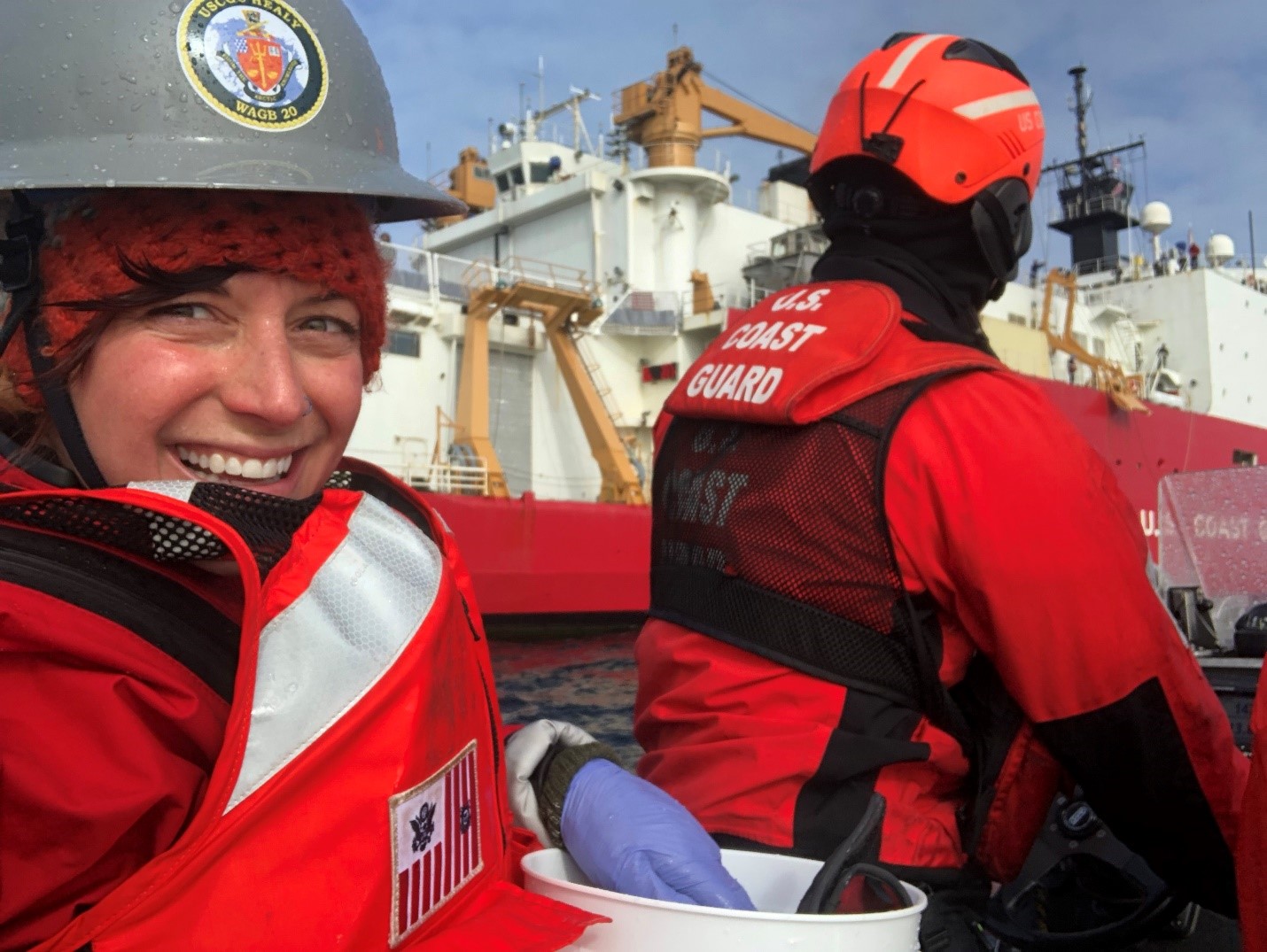Getting Ready for Science on Ice
Published: 19 August 2019
Hopeful and hardy, researchers prepare for a yearlong field campaign in the central Arctic

On a recent midsummer afternoon in Boulder, Colorado, Matthew Shupe jogged between a laboratory on the third floor of the National Oceanic and Atmospheric Administration (NOAA) building and a staging area in the basement.
Shupe, a University of Colorado research scientist, also jogged out to the parking lot, where helpers were packing seatainers with instruments and other gear.
With a decade of hope and preparation behind him, Shupe is getting ready for the Multidisciplinary Drifting Observatory for the Study of Arctic Climate (MOSAiC) field campaign, billed as the world’s most advanced research expedition to the central Arctic.
Starting in September 2019, at a wharf in Tromsø, Norway, technicians will deploy advanced instruments from 60-plus institutions worldwide onto decks and railings on the German icebreaker R/V Polarstern.
By October, the Polarstern will be out to sea and frozen into place to drift toward (and past) the North Pole. The instruments will measure atmosphere, ice, ocean, and ecosystem conditions.
The MOSAiC mission is to investigate the causes and consequences of diminished ice cover in a top-of-the-world region where temperatures are rising at twice the global average.
With a promise of unprecedented data starting in 2020, the expedition is “a once-in-a-lifetime opportunity,” says Shupe, who oversaw the writing of the MOSAiC science plan and is a co-coordinating scientist for the expedition.
MOSAiC organizers, based at the Alfred Wegener Institute (AWI) in Germany, say that scientists taking part may be among the last to witness year-round ice cover in the Arctic Ocean.
Intensive Attention

MOSAiC’s interdisciplinary researchers will take an intensive, all-season look at the central Arctic. The U.S. Department of Energy (DOE), one of MOSAiC’s largest American sponsors, is critically involved through its Atmospheric Radiation Measurement (ARM) user facility.
DOE is also providing funding for some MOSAiC researchers, including Shupe, through its Atmospheric System Research program.
ARM technicians will install and maintain “an unprecedented cloud observatory” in the Arctic, says Shupe, a 15-year ARM collaborator.
The observatory is the second ARM Mobile Facility (AMF2), a portable instrument package largely designed to support shipboard research deployments. For the most part, it will operate out of eight ARM seatainers on the bow of the Polarstern, but some observatory instruments will also be set up at ice camps near the frozen-in ship.
AMF2 will include the first scanning cloud radar to be deployed in the arctic ice pack, along with a precipitation suite, three radiation suites, and instruments for profiling wind and atmospheric conditions.
Embedded with ARM’s onboard aerosol observing system will be enhanced aerosol observing instruments provided by University of Michigan professor Kerri Pratt and Colorado State University research scientist Jessie Creamean. Both are atmospheric chemists.
ARM will have a big hand in the campaign, says Shupe, and afterwards will likely have collected “far more data than any other participant in support of arctic science.”
See Matt Run
“It’s been amazing watching Matt.”
Taneil Uttal, who works alongside Matthew Shupe at the NOAA Earth System Research Laboratory
While jogging up and down stairs in late July, Shupe was aware of the similar fervent preparations going on among MOSAiC participants from 17 countries. (Editor’s note: As of September 17, 2019, the number of countries participating is 19.) From October 2019 through October 2020, about 300 scientists and technicians will rotate in and out of the drift site, he says, ferried there by MOSAiC partner icebreakers.
Shupe will be out on the ice for about six months, starting with the campaign’s first research leg and again during its last. There are six research legs from two to three months long.
Another, called 1a, will last about 40 days. That will be enough time for eight experts to ride out with the expedition into the arctic ice pack, help calibrate instruments as the Polarstern freezes in, and then ride back on a Russian icebreaker to the expedition’s starting point in Norway.
The Leg 1a installation team is led by AMF2 operations manager David Chu, a research technologist at Los Alamos National Laboratory (LANL) in New Mexico.
He will be joined by:
- instrument mentors Janek Uin and Matthew Boyer of Brookhaven National Laboratory in New York
- two ARM contractors from Hamelmann Communications in Colorado, Jody Ellis and Dean Greenamyer
- LANL operations staffers Peter Argay, an ARM radar team member, and Paul Ortega
- Misha Krassovski, an information technology engineer from Oak Ridge National Laboratory in Tennessee.
Meanwhile, “it’s been amazing watching Matt,” says Taneil Uttal, a veteran arctic scientist and supervisory meteorologist who works alongside Shupe at the NOAA Earth System Research Laboratory.
Uttal will join MOSAiC for Leg 2, supporting Shupe’s surface energy flux project, designed to gather data on exchanges of energy and heat between the ice and the atmosphere. It’s funded by the National Science Foundation and NOAA.
Uttal is busy pitching in, but Shupe and his engineering and logistics team “are really the ones going crazy during the deployment,” she says―working 10 or 12 hours a day to get ready. Shupe, who is also a woodworker, has spent weekends replacing seatainer insulation and flooring.
“Matt has been, end-to-end, hands-on with this project,” says Uttal, describing Shupe as both a senior scientist and the guy who decides “the most dreary things, like how many boxes of Kleenex we should have.”
An Army of Details

The expedition will marshal an army of resources on behalf of science, including support icebreakers, helicopters, and fixed-wing aircraft. The Polarstern is the main observatory, but there will also be a regional distributed network of sea ice stations and Arctic-wide linkages with collaborating research aircraft and vessels, arctic buoys, and satellite feeds.
All that demands a grasp of details of the kind AMF2 site manager Chu has to deal with as he oversees installing instruments during MOSAiC.
“Plenty of spare parts,” advises MOSAiC participant Gijs de Boer, an arctic scientist at the Cooperative Institute for Research in Environmental Sciences at the University of Colorado, Boulder, which is affiliated with the NOAA Earth System Research Laboratory. “Six months in the central Arctic is no joke. No opportunities to ship up a part if something breaks.”
Spare parts aside, Shupe has also helped ARM anticipate problems, from coping with limited power on the ice to the need for strategically placed heaters.
In April 2019 at LANL, he provided scientific guidance to an ARM team beta-testing instruments for MOSAiC.
Creamean, a veteran high-latitudes researcher, was there too―and will also be on the Polarstern on Leg 1, with Shupe.
“I am honored and excited to help and be a part of such an incredible opportunity,” she says.
Anyone aboard the Polarstern has to meet strict requirements. In July 2019, Creamean participated in a Colorado training session on arctic field safety and another in Florida on watchkeeping (shipboard duties) for seafarers.
The Things They Will Carry

Creamean is packing personal gear: an iPad stacked with journal articles, shampoo, a yoga mat, and her pair of well-worn arctic boots.
Shupe is taking a yoga mat too, along with woodcarving equipment, music, exercise gear, and stuff that has gotten him though a lifetime of cold-weather deployments:
- goggles (“a must,” he says)
- a goose down parka (temperatures could get to minus 40 degrees Fahrenheit)
- gloves for every occasion―big expedition-weight mitts, insulated leather work gloves, and silk glove liners for dexterous work.
Lead ARM technician Vagner Castro will be aboard the Polarstern for Legs 1 and 4.
“AWI will provide all boots, clothes, and food,” says Castro. “I will be taking only my personal laptop with me—and underwear.”
On Leg 1a, Krassovski, the Oak Ridge engineer, will set up communications and networking equipment for AMF2. He is packing his cameras and a personal unmanned aerial system for aerial photography.
Bonnie Light, principal physicist at the University of Washington’s Applied Physics Laboratory, will be on MOSAiC’s summertime Leg 5, when temperatures should hover steadily around the freezing mark.
To combat the toll of 24-hour sunlight and of sometimes working bare-handed, Light is taking hand lotion. She will also pack an eyeshade for sleeping―and something green.
On her first campaign in the Arctic 20 years ago, “I was so well calibrated to white and black, and all the grays in between, I lost track of color,” she says.
By chance, Light had brought a grass-colored notebook. She would look at it and say to herself: “That’s what green looks like. Don’t forget.”
Keep up with the Atmospheric Observer
Updates on ARM news, events, and opportunities delivered to your inbox
ARM User Profile
ARM welcomes users from all institutions and nations. A free ARM user account is needed to access ARM data.


















